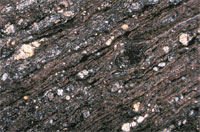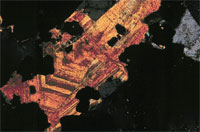



NDSU Geosciences Petrology 422/622 Spring 2014
STUDENT TERM PROJECTS


Our objective during the last section of the class is to exercise our petrology muscles, by gaining some hands-on knowledge of a specific petrologic topic, and by presenting the results of our research to an audience.
Topic Selection: Working in teams of one or two, select an igneous or metamorphic site or suite of samples that is of particular interest to you. There are a number of sample suites available in the department from previous field trips. Those of you going on a spring break trip may be able to collect samples that could be used for a project, but remember, it will take time to make thin sections, so you'll have to work quickly to prepare your project. You may also carry out a mathematical or geochemical modeling project based on literature data. All topics must be approved.
Titles Due: Term project titles should be turned in to me by Friday, March 14.
Research: Investigate your samples thoroughly by observing hand samples and thin sections. Chemical analysis by XRF is available in the Dept. of Geosciences, SEM microchemical analysis is available in the NDSU Electron Microscopy Center, and XRD facilities are available in the Materials and Characterization Laboratory of the Dept of Chemistry and Biochemistry. Many other analytical instruments are available across campus - inquire with me for details. Carrying out relevant experiments is also a possibility. Thorough analysis of data from the literature on your sample area may be possible as a research project, but this type of project must be much more than a "book report." You are encouraged to use diverse source materials, including maps, state and federal reports, journals and books to provide background information for your project. Your project should include significant content based on your personal efforts. Be creative!
Class Presentation: For your 15 minute presentation to class, describe what motivated you to study the chosen topic, the geologic background of your samples, and a summary of the results of your research, with diagrams or pertinent data. Bring sufficient copies of a one-page double-sided summary to class. Include a "references cited" section that lists those materials that you actually used in the preparation of your report.
Presentation Dates: Presentations will be made on April 29, May 1, and May 6.
Course Points: 20% of grade
|
|
Projects: Topics and Schedule Tuesday, April 29
Kristen Lorenz and Kathryn Klokstad
Bill Leonard
Chase Hillebrand
Amos Albert and Jessica Eagle-Bluestone Thursday, May 1
Alex Van Ningen and Adam Sagaser
Kris Ekart
Lisa Romano Title: Mineralogy of palagonite and hydroclastite from Iceland Abstract: Palagonite is found in several locations in Iceland, but what is it made of? Through clay XRD and XRF on pressed pellets, the composition of palagonite is hoped to be confirmed. Cheyanne Jacobs and Jackie Wrage Title: Geochemistry and Mineralogy of Glacial Cobbles, Dry Valleys, Antarctica Abstract: We will be carrying out X-Ray Fluorescence Analysis on Antarctic granite cobbles using glass disks and powder disks. We will compare our results to the 2008 sample results to compare our methods with previous methods. We will also be doing X-Ray Diffraction on potassium feldspar grains to determine the amount of substitution of Al for Si occurring to possibly determine the depth at which crystallization happened. Nick Hugo Title: Ore Mineralogy, Red Dog Deposit, Alaska Abstract: The Red Dog Mine is a lead-zinc sulfide mine located in northwestern Alaska near Kotzebue on the southern portion of the Brooks Range. The host rock of the main deposit was initially deposited under quiescent sea floor conditions resulting in stratified chert and carbonaceous shale with lenses of carbonate rock (Morelli et. al., 2004). The primary deposit is part of a series of thrust sheets that were uplifted and deformed during an orogeny occurring in the middle Jurassic (Moore et. al., 1986). My research centers on the depositional sequence of events leading to the formation of the Red Dog deposit as there is some debate as to the actual process of deposition (hydrothermal, tectonic igneous activity, etc.). Reflected Light Microscopy and Scanning Electron Microscope (SEM) analysis were both conducted to determine the mineral assemblage within the provided sample. The mineral assemblage observed was Galena, Sphalerite (unspecified type), Pyrite, and Quartz. The SEM confirmed these results and provided chemical analyses of each mineral grain as shown below. Further analysis of these results shows this deposit is of hydrothermal origin that occurred before the middle Jurassic orogeny (Edgerton, 1997). The environment of deposition for the observed mineral grains was hydrothermally derived as well (Pracejus, 2008). Tues, May 6 Eric Wilcox and Monty Johnson Title: Comparison of Chalky Buttes Porphyry, ND with Porphyry from Near Forsyth, MT Abstract: We will investigate the source of volcanic porphyry cobbles found in the Chalky Buttes member of the Chadron Formation, North Dakota. We will compare the cobbles with the Flaxville cobbles found in the Yellowstone River, which are very similar in appearance. We will analyze each cobble's whole rock chemistry and compare distinct plagioclase crystals in each of the two cobbles. We plan to gather our data by using XRF, SEM, and microscopic analysis. Brian Kaeter and Darin Wilwand Title: Igneous and Metamorphic Rocks from Patagonia, Argentina Abstract: Samples from the El Cuy region of northern Patagonia, Argentina were examined to determine the formation of the region. This region was previously determined to be an allochthonous, or foreign landmass, that collided with north and central Patagonia. Recent discoveries have taken steps in the other direction to argue against an allochthonous region, such as no indication of subducted ocean floor between northern Patagonia and the rest of the Argentina. The new hypothesis explains the geology of region by the presence of a continental transcurrent fault resulting from the Gondwanide Orogony. Granites can be used to determine tectonic origin through trace element discrimination by perform XRD tests. Results of the tests plot as volcanic arc granites. Samples of metamorphic mylonites where studied to determine if the micro-structures within them hold clues to the formation of the region. A brief definition and classification of mylonites will be given, along with a discussion of shear zones.
Christina Lammers and Andrew Van Sickle Ben Munson Title: Chemical and Mineralogical Analysis of Devils Tower, Wyoming Abstract: A single hand sample was used to analyze the whole rock chemistry, and the phenocryst chemistry of Devils Tower. Analysis on the sample revealed the presence of a unique mineral called analcime, which was investigated further through this research. The sample was first analyzed using x-ray fluorescence (XRF). Whole rock chemistry was compared to previous whole rock chemistry analysis of Devils Tower. The results showed that the sample had a whole rock chemistry of a tracheae. This differs from previous work done on Devils tower which has traditionally plotted the rock as a phonolite. Although this is different from previous work, trachytes and phonolites are similar and only vary slightly in chemistry. A Scanning Electron Microscope (SEM) was also used in analyzing the Devils Tower sample. The SEM was used to identify the large phenocrysts in the sample. The results of the SEM showed that most of the phenocrysts were either anorthoclase (Na,K)AlSi3O8 or aegirine-augite ((Ca,Na)(Mg,Fe+2, Fe+3)Si2O6. A third analysis on the Devils Tower sample was done using X-Ray Diffraction (XRD) data that had previously been collected. The XRD data allowed for the identification of analcime, Na(AlSi2O6)-H2O, which is an uncommon but significant mineral. Anorthoclase peak were also identified.

NDSU Home | Geosciences Home | Petrology Home Page | B. Saini-Eidukat Petrology Geology 422/622 |